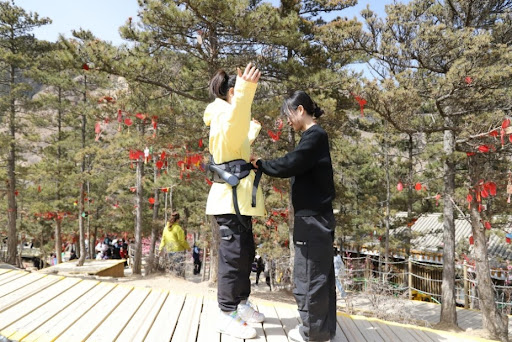By Fan Haotian, Tian Xianjin, Wang Zhe, People’s Daily
With crisp spring air and sun-drenched skies drawing crowds into the mountains, many hikers across China are finding that their treks now come with a new companion: cutting-edge robotic assistance.
High above the forested valleys of central China’s Hubei province, the Enshi Grand Canyon draws visitors with jagged cliffs and towering peaks, creating a dramatic and awe-inspiring landscape. During this year’s Qingming Festival holiday, the area welcomed 25,000 tourists – a year-on-year increase of over 30 percent.
For Mr. Yang, a local resident recovering from a leg fracture, the journey tothe Qixingzhai scenic area of the canyon began with a cable car ride. But the real challenge came after: a daunting staircase carved into the mountainside. Still hesitant to push his limits, Yang was offered something unexpected – a wearable robotic exoskeleton.
In seconds, the lightweight devicewas strapped to his waist and legs. To his surprise, each step grew easier. “It’s like wearing a waist pack,”he said. “You can really feel the push going uphill – even on level ground, it helps you move forward.”
Recently, the scenic area brought in more than a dozen robotic exoskeletons from Shenzhen, the tech hub in south China’s Guangdong province. Lightweight at just around 1.8 kilograms, the devices offer three to five hours of battery life and six power levels, allowing users to fine-tune their experience – dialing up for steep climbs, or easing off on gentler paths.
In parks and peaks across China, high-tech hiking aids are no longer a novelty – they are quickly becoming part of the outdoor experience.The rise of wearable robotics reflects a broader wave of innovation sweeping through the country’stourism and fitness industries, making trails more accessible to a wider public, including those with limited mobility.
At Helan Mountain National Forest Park in Yinchuan, northwest China’s Ningxia Hui autonomous region, more than 20,000 tourists visited during this year’s Qingming Festival holiday. About 300 tourists of them strapped into robotic hiking gear.
Elsewhere, iconic destinations like Mount Taishan and Huangshan Mountain are also embracing the shift. Visitors can now rent not only robotic exoskeletons but also smart trekking poles and robotic walking assistants – all designed to ease the burden of steep inclines and long trails.
“These products are incredibly popular and often booked out in advance,” said a staff member at Mount Taishan scenic area. Since January, the scenic spot has offered robotic hiking assistants for rent at 80 yuan ($10.92) for a three-hour session- and demand has been brisk.
Mile Bot, a robotics company based in Huangshan city, east China’s Anhui province, has developed a smart walking robot tailored for outdoor hiking and stair climbing. The device recently underwent field trials on the slopes of Huangshan Mountain.
“We gathered a great deal of user feedback during the trials,” said Zuo Zongsheng, a company executive. “Now we’re refining the design to make the product more intuitive and user-friendly.”
The robot’s core design draws from Mile Bot’s experience in rehabilitation robotics, where the company has developed medical-assist products, including exoskeletons for lower-limb paralysis recovery and treadmill-based recovery devices in medical setting. The hiking model, by comparison, is sleek and compact: a battery pack, motorized power arm, thigh straps and fasteners make up the entire unit.
“Flip the switch, and the motor kicks in, guiding your leg forward with every step,” Zuo explained. “It takes less than 30 seconds to put on, and users can select from five power levels based on the terrain.”
What sets the device apart, Zuo said, is its flexible drive system – designed to mimic natural movement more smoothly than traditional rigid mechanisms. It not only feels safer but also more responsive to the user’s stride.
Looking ahead, Mile Bot plans to trim the device’s weight, bolster its durability,and introduce seasonal versions with breathable or insulated materials for different weather conditions.
While tourists are the primary market, the company also sees broader applications: the exoskeletons are already being tested for use by sanitation crews and goods porters in scenic areas, promising a high-tech lift for more than just hikers.
